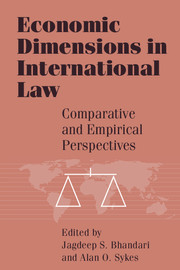Book contents
- Frontmatter
- Contents
- Preface
- Introduction: Economics and international law
- 1 The economics of the most favored nation clause
- 2 The economics of “injury” in antidumping and countervailing duty cases
- 3 The economics of “injury” in antidumping and countervailing duty cases: A reply to Professor Sykes
- 4 Innovations in support of the unitary injury test in U.S. unfair trade cases
- 5 The free trade–fair trade debate: Trade, labor, and the environment
- 6 International conflict and coordination in environmental policies
- 7 Market modernization of law: Economic development through decentralized law
- 8 Toward a positive theory of privatization: Lessons from Soviet-type economies
- 9 New stories on exchange rate policies in transition
- 10 Is deposit insurance inevitable? – lessons from Argentina
- 11 The market for migrants
- 12 The interplay of liquidation and reorganization in the bankruptcy systems of Canada and the United States: The role of screens, gatekeepers, and guillotines
- 13 International political economy approaches to international institutions
- 14 The trade effects of domestic antitrust enforcement
- 15 The Hartford Insurance Company case: Antitrust in the global economy – welfare effects and sovereignty
- 16 Recognition of foreign judgments as a trade law issue: The economics of private international law
- 17 Externalities and extraterritoriality: The law and economics of prescriptive jurisdiction
- Index
2 - The economics of “injury” in antidumping and countervailing duty cases
Published online by Cambridge University Press: 05 December 2011
- Frontmatter
- Contents
- Preface
- Introduction: Economics and international law
- 1 The economics of the most favored nation clause
- 2 The economics of “injury” in antidumping and countervailing duty cases
- 3 The economics of “injury” in antidumping and countervailing duty cases: A reply to Professor Sykes
- 4 Innovations in support of the unitary injury test in U.S. unfair trade cases
- 5 The free trade–fair trade debate: Trade, labor, and the environment
- 6 International conflict and coordination in environmental policies
- 7 Market modernization of law: Economic development through decentralized law
- 8 Toward a positive theory of privatization: Lessons from Soviet-type economies
- 9 New stories on exchange rate policies in transition
- 10 Is deposit insurance inevitable? – lessons from Argentina
- 11 The market for migrants
- 12 The interplay of liquidation and reorganization in the bankruptcy systems of Canada and the United States: The role of screens, gatekeepers, and guillotines
- 13 International political economy approaches to international institutions
- 14 The trade effects of domestic antitrust enforcement
- 15 The Hartford Insurance Company case: Antitrust in the global economy – welfare effects and sovereignty
- 16 Recognition of foreign judgments as a trade law issue: The economics of private international law
- 17 Externalities and extraterritoriality: The law and economics of prescriptive jurisdiction
- Index
Summary
The General Agreement on Tariffs and Trade (GATT), now incorporated into the treaty creating the World Trade Organization (WTO), defines “dumping” as the sale of goods in an importing nation at a price below their “normal value.” Such conduct entails either price discrimination in favor of buyers in the importing nation or sales below (roughly) longrun average cost. Subsidization under GATT arises from a “bounty or subsidy bestowed, directly or indirectly, upon the manufacture, production or export of any merchandise.” GATT allows importing nations to counteract dumping and subsidization with import duties that would otherwise violate negotiated GATT tariff ceilings. In response to dumping by foreign firms, importing nations may impose an “antidumping duty not greater in amount than the margin of dumping” (i.e., the amount by which the price is less than “normal value”). In response to subsidization, a “countervailing duty” may be imposed on imported merchandise as long as it is not “in excess of an amount equal to the estimated bounty or subsidy determined to have been granted.” Before either an antidumping or countervailing duty may be imposed, however, GATT requires the importing nation to determine “that the effect of the dumping or subsidization, as the case may be, is such as to cause or threaten material injury to an established domestic industry, or is such as to retard materially the establishment of a domestic industry.” This requirement, known as the “injury test” or “material injury test,” is the subject of this chapter.
- Type
- Chapter
- Information
- Economic Dimensions in International LawComparative and Empirical Perspectives, pp. 83 - 125Publisher: Cambridge University PressPrint publication year: 1998
- 2
- Cited by



